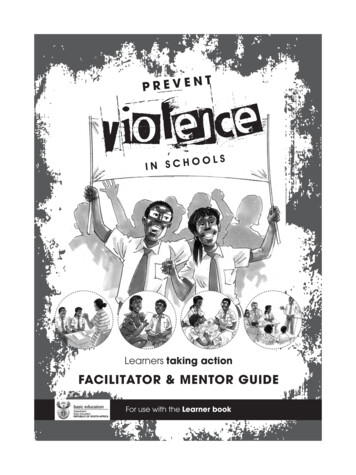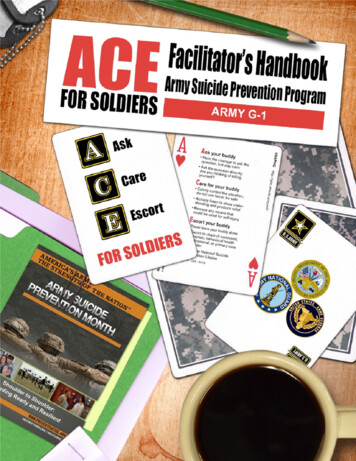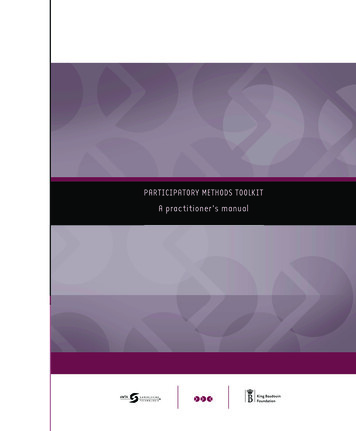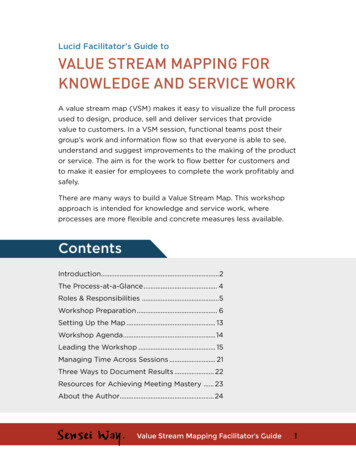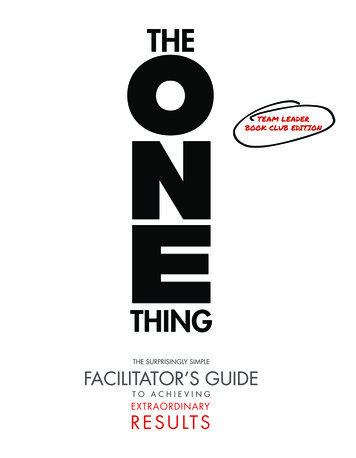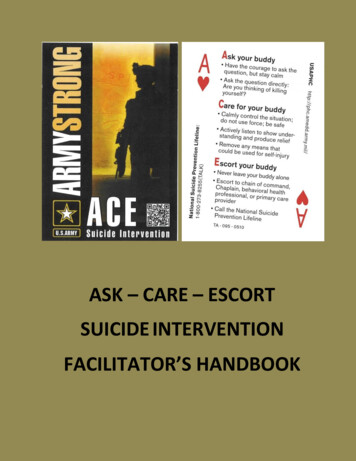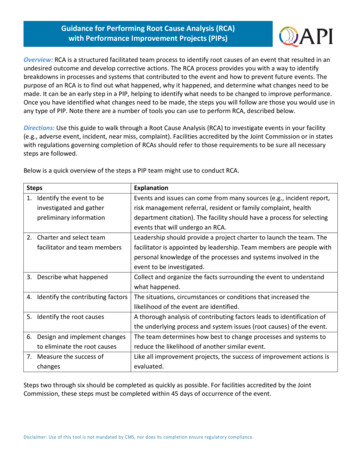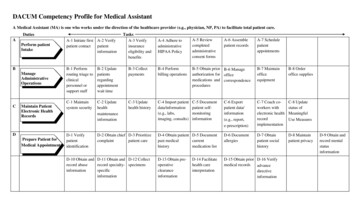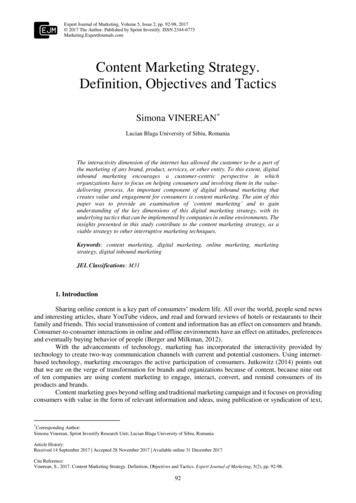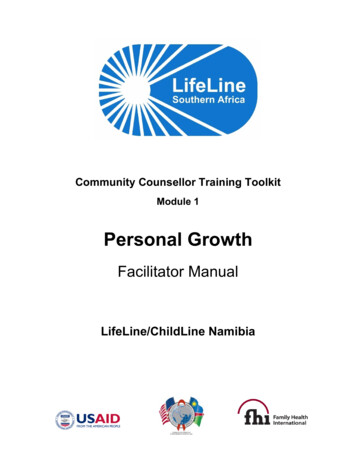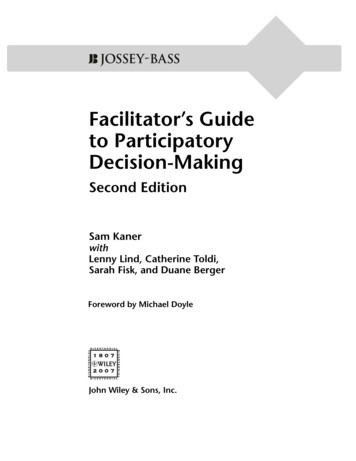
Transcription
Facilitator’s Guideto ParticipatoryDecision-MakingSecond EditionSam KanerwithLenny Lind, Catherine Toldi,Sarah Fisk, and Duane BergerForeword by Michael DoyleJohn Wiley & Sons, Inc.
PRAISE FOR THIS REMARKABLE BOOK!“As a leader of a firm involved with the governance and strategicoversight of multi-billion dollar organizations and portfolios, wefind the principles and techniques in this book incredibly valuablein advancing the thinking of executive teams and boards. It has adirect effect on the impact our organizations have. Leaders andmanagers of any organization can benefit from the wisdom andpragmatic advice which this book delivers so effectively.”—Mike Mohr,founder and CEO, Comprehensive Financial Management LLC“The brilliant and innovative tools in this book have had aprofound effect on the way we in the Playfair organization run ourmeetings. Many of the Playfair facilitators who have been trainedin the models presented here have achieved fabulous results withtheir clients, helping their interactions come alive with fun,originality and innovation. Highly recommended!”—Matt Weinstein,founder, Playfair Inc, and author, Managing To Have Fun“In the field of international development, managing participatorydecision-making among people from diverse backgrounds andcultures is a necessity not an option. Our organization employs astaff of several thousand who touch the lives of hundreds ofmillions of people living in poverty, in developing nations acrossthe globe. As we build our capacity to convene and facilitatemulti-stakeholder processes, we have found Sam Kaner’s book andhis teachings to be immensely beneficial. I strongly recommendFacilitator’s Guide to Participatory Decision-Making to anyone whowants a deeper appreciation of the skills required to buildsustainable agreements.”—Jamie Watts,Institutional Learning and Change, Bioversity International,Consultative Group for International Agricultural Research,Rome, Italyi
“Sam Kaner is one of the world’s leading experts on collaboration.His grasp of the challenges and dilemmas of collaboration issuperb, as are his models and methods for facilitating complexprocesses. The second edition of this widely-used book reflects hisaccumulated wisdom and teachings. Clearly written andwonderfully illlustrated, this book makes difficult issuesunderstandable and provides sound, practical guidance.”—Sandy Schuman, editor, Creating a Culture of Collaborationand founding editor, Group Facilitation: A Research and ApplicationsJournal“Facilitator’s Guide to Participatory Decision-Making is anoutstanding resource for tackling complex community andbusiness challenges. We have used it for strategic planning in ournationally recognized child welfare programs and in ourinnovative programs to end homelessness. The second editionadds many helpful process management tools, and the newmaterial on difficult dynamics is brilliant. I keep a copy on mydesk for easy reference.”—Roxane White, CEO, Denver Department of Human Services“When I first heard about participatory decision-making, myreaction was that it sounded like a nice idea but I didn’t see itsrelevance for my role as a leader and CEO. After seeing Sam Kanerand his colleagues facilitate so effectively in many different highstake contexts, I have completely changed my mind. I nowrecognize that a highly participatory approach is often the mosteffective way to develop and drive strategy, particularly whendealing with complex problems with highly diverse participants.Reading Facilitator’s Guide was an ‘aha’ experience for me; itdescribed the group dynamics that had previously beenmysterious, and it showed me how to work with them effectively.Kaner’s decision-making procedures are the best I’ve ever seen.At Goodwill, we use them all the time. The new edition gives usseveral more valuable tools to be effective at making decisions.For anyone who values collaboration and wants to put its guidingprinciples into practice, the book is a must-read!”—Deborah Alvarez-Rodriguez, president and CEO, GoodwillIndustries of San Francisco, San Mateo and Marin Countiesii
“In my opinion, Facilitator’s Guide to Participatory Decision-Makingis the best book on collaboration ever written. I say this assomeone who has been a CEO or executive director for more than20 years. During that time I have worked with countlessfacilitators and organization development consultants. For depthof impact and overall effectiveness, Sam Kaner and his colleaguesare top-of-the-line. This book is loaded with the tools and guidingprinciples that make Sam’s work so compelling.”—Diane Flannery, founding CEO, Juma Ventures, and director,Global Center for Children and Families, UCLA, Semel Institute“Sam Kaner and his team have helped me create a culture ofcollaboration in science. This is no easy task! Twenty-five yearsago I started with nothing. Now my organization has thepotential to make a large impact by discovering causes of the mostdevastating diseases that affect children. Sam’s superb skills instrategic thinking and group facilitation, and his deep expertise inorganization design and systems change have been essential forour success. In Facilitator’s Guide to Participatory Decision-Making,Sam and his team translate their own learnings from manydifferent kinds of work environments into concrete techniquesthat will benefit business, government and non-profits alike.”— John Harris,founder and CEO, California Birth Defects Monitoring Program,California Department of Health Services“Facilitator’s Guide gives readers tools and insights to enableeffective participatory action and the potential to achieve strongprincipled results and positive social change.”— Michael Doyle, author, How to Make Meetings Work“I am a longtime client and colleague of Community At Work.They are extraordinarily talented at facilitating effective teams andteaching others to do the same. Their consulting approach createslasting solutions by promoting organizational health throughcollaborative working relationships. Facilitator’s Guide reveals andexplains many of their most compelling methods and practices.”—Ed Pierce, founder and CEO, Leadership Quality Inc.iii
“Facilitator’s Guide takes the mystery and fear out of facilitatinggroups and provides useful tools for anyone working with groups.The materials are clear. The graphics are first rate. And complexissues are developed logically and with great care.”—Thomas Broitman, managing director,Executive Education, PricewaterhouseCoopers, LLP“This book is a must for anyone working with a team! It is loadedwith new information, which will make your team facilitation anddecision-making even better. It highlights key concepts underlyinggroup process that are rarely defined in such a clear manner. And,at the same time, it provides easy-to-follow facilitation techniquesto ensure group participation and convergence around decisionsand ideas. This is a book that rarely stays on my shelf- I’m too busyusing it as a reference. Truly a golden nugget in the vast pool offacilitation knowledge!”—Tammy Adams, author, Facilitating the Project Lifecycle“What a practical, sensible guide for helping groups work togetherin a realistic way! The graphics help you visualize how to managemany common – and puzzling – aspects of group behavior.”—Marvin Weisbord, consultant and author, Productive Workplacesand co-author, Discovering Common Ground and Future Search“Marshall Medical Center is community based, and we have alwaysvalued a culture of participation. We frequently make inclusivedecisions allowing buy-in to difficult actions we need to take as anorganization. Using Facilitator’s Guide to Participatory DecisionMaking and working with Sarah Fisk has helped us to maintain andeven increase participation while still making timely decisions.Rather than simply relying on Sarah, who is a true genius atfacilitation, this book has allowed us to build our own capacity.We've learned how to convene multiple stakeholder teams, planeffectively, and make more sustainable decisions, thus maintainingour collaborative values as we grow to serve a wider community. Ihighly recommend this book.”—James Whipple, CEO,Marshall Medical Center, El Dorado County, Californiaiv
Facilitator’s Guideto ParticipatoryDecision-MakingSecond EditionSam KanerwithLenny Lind, Catherine Toldi,Sarah Fisk, and Duane BergerForeword by Michael DoyleJohn Wiley & Sons, Inc.
Copyright 2007 by Community At Work.Published by Jossey-BassA Wiley Imprint989 Market Street, San Francisco, CA 94103-1741 www.josseybass.comNo part of this publication may be reproduced, stored in a retrieval system, ortransmitted in any form or by any means, electronic, mechanical, photocopying,recording, scanning, or otherwise, except as permitted under Section 107 or 108 of the1976 United States Copyright Act, without either the prior written permission of thepublisher, or authorization through payment of the appropriate per-copy fee to theCopyright Clearance Center, Inc., 222 Rosewood Drive, Danvers, MA 01923, 978-7508400, fax 978-646-8600, or on the Web at www.copyright.com. Requests to thepublisher for permission should be addressed to the Permissions Department, John Wiley& Sons, Inc., 111 River Street, Hoboken, NJ 07030, 201-748-6011, fax 201-748-6008, oronline at http://www.wiley.com/go/permissions.Limit of Liability/Disclaimer of Warranty: While the publisher and author have used theirbest efforts in preparing this book, they make no representations or warranties withrespect to the accuracy or completeness of the contents of this book and specificallydisclaim any implied warranties of merchantability or fitness for a particular purpose. Nowarranty may be created or extended by sales representatives or written sales materials.The advice and strategies contained herein may not be suitable for your situation. Youshould consult with a professional where appropriate. Neither the publisher nor authorshall be liable for any loss of profit or any other commercial damages, including but notlimited to special, incidental, consequential, or other damages.Readers should be aware that Internet Web sites offered as citations and/or sources forfurther information may have changed or disappeared between the time this was writtenand when it is read.Jossey-Bass books and products are available through most bookstores. To contactJossey-Bass directly call our Customer Care Department within the U.S. at 800-956-7739,outside the U.S. at 317-572-3986, or fax 317-572-4002.Jossey-Bass also publishes its books in a variety of electronic formats. Some content thatappears in print may not be available in electronic books.Library of Congress Cataloging-in-Publication DataKaner, Sam.Facilitator's guide to participatory decision-making / Sam Kaner withLenny Lind . . . [et.al.].p. cm.Includes bibliographical references and index.ISBN-13: 978-0-7879-8266-9 (cloth)1. Group decision-making —Handbooks, manuals, etc. 2. Consensus(Social Sciences) —Handbooks, manuals, etc. 3. Management–Employeeparticipation—Handbooks, manuals, etc. I. Lind, Lenny II. Title.HD30.23.K2753 2007658.4 ' 036–dc222006037961Printed in the United States of AmericaSECOND EDITIONPB Printing10 9 8 7 6 5 4 3 2 1Cover art by Karen Kerney.Book design by Lenny Lind/CoVision and Sam Kaner.vi
THE JOSSEY-BASSBUSINESS & MANAGEMENT SERIESvii
DEDICATIONThis book is dedicated to Michael Doyle and David Straus,who found the language, the distinctions, and the methodsto bring inclusive, participatory values into the mainstreamof American management practicesand who, through their own continuing efforts and those oftheir students and grandstudents and great-grandstudents,may yet inspire humanity to use collaborative technologyfor finding sustainable, nonviolent solutions to the world’stoughest problems.viii
CONTENTSForeword by Michael DoyleIntroductionxixviiPart I: Grounding Principles123The Dynamics of Group Decision-Making . . . . . . . . . . . .Participatory Values . . . . . . . . . . . . . . . . . . . . . . . . . . . . .Introduction to the Role of Facilitator . . . . . . . . . . . . . . .32331Part II: Facilitator Fundamentals456789101112Facilitative Listening Skills . . . . . . . . . . . . . . . . . . . . . . . .ChartWriting Technique . . . . . . . . . . . . . . . . . . . . . . . . .Facilitating Open Discussion . . . . . . . . . . . . . . . . . . . . . .Alternatives to Open Discussion . . . . . . . . . . . . . . . . . . .Brainstorming . . . . . . . . . . . . . . . . . . . . . . . . . . . . . . . . . .Tools for Managing Long Lists . . . . . . . . . . . . . . . . . . . . .Dealing with Difficult Dynamics . . . . . . . . . . . . . . . . . . .Effective Agendas: Desired Outcomes . . . . . . . . . . . . . . .Effective Agendas: Process Design . . . . . . . . . . . . . . . . . .41617589117123135155173Part III: Building Sustainable Agreements13141516Principles for Building Sustainable Agreements . . . . . . . .Gathering Diverse Points of View . . . . . . . . . . . . . . . . . . .Building a Shared Framework of Understanding . . . . . . .Developing Inclusive Solutions . . . . . . . . . . . . . . . . . . . .191203221237Part IV: Reaching Closure17181920Importance of Clear Decision Rules . . . . . . . . . . . . . . . . .Striving for Unanimity . . . . . . . . . . . . . . . . . . . . . . . . . . . .Reaching Closure Step by Step . . . . . . . . . . . . . . . . . . . . . .Facilitating Sustainable Agreements . . . . . . . . . . . . . . . . .265275289303Photocopying Policy . . . . . . . . . . . . . . . . . . . . . . . . . . . . . . .Bibliography . . . . . . . . . . . . . . . . . . . . . . . . . . . . . . . . . . . .Acknowledgments . . . . . . . . . . . . . . . . . . . . . . . . . . . . . . . .The Authors . . . . . . . . . . . . . . . . . . . . . . . . . . . . . . . . . . . .Index . . . . . . . . . . . . . . . . . . . . . . . . . . . . . . . . . . . . . . . . . .Training from Community At Work . . . . . . . . . . . . . . . . . . .313315319323325341ix
FOREWORD to the First EditionBy Michael DoyleI see group facilitation as a whole constellation of ingredients:a deep belief in the wisdom and creativity of people; a searchfor synergy and overlapping goals; the ability to listen openlyand actively; a working knowledge of group dynamics; a deepbelief in the inherent power of groups and teams; a respect forindividuals and their points of view; patience and a hightolerance for ambiguity to let a decision evolve and gel; stronginterpersonal and collaborative problem-solving skills; anunderstanding of thinking processes; and a flexible versus alock-step approach to resolving issues and making decisions.Facilitative behaviors and skills are essential for anyone whowants to work collaboratively in groups and organizationstoday. Facilitative skills honor, enhance, and focus the wisdomand knowledge that lay dormant in most groups. These skillsare essential to healthy organizations, esprit de corps, fair andlasting agreements, and to easily implement actions and plans.Sam Kaner and the team from Community At Work have beendeveloping and articulating these tools to further democraticaction and to enable people from all walks of life to worktogether in more constructive and productive ways. TheFacilitator’s Guide to Participatory Decision-Making will givereaders additional tools and insights to enable effective,participatory action and the potential to achieve strong,principled results and positive social change. Anyone wantingto increase their understanding of group dynamics and improvetheir skill at making groups work more effectively will benefitfrom this valuable book.The Purpose of Group FacilitationThose who work with and lead organizations today havelearned two lasting lessons in the last twenty-five years ofconcerted action research in this field of organizationdevelopment and change. Lesson one: if people don’tparticipate in and “own” the solution to the problems or agreeto the decision, implementation will be half-hearted at best,probably misunderstood, and, more likely than not, will fail.xi
The second lesson is that the key differentiating factor in thesuccess of an organization is not just the products and services,not just its technology or market share, but the organization’sability to elicit, harness, and focus the vast intellectual capitaland goodwill resident in their members, employees, andstakeholders. When that intellectual capital and goodwill getenergized and focused, the organization becomes a powerfulforce for positive change in today’s business and societalenvironments. Applying these two lessons has become a keyelement of what we have begun to think of as the learningorganization.How do leaders and their organizations apply these two lessons?By creating psychologically safe and involving groupenvironments where people can identify and solve problems,plan together, make collaborative decisions, resolve their ownconflicts, trouble-shoot, and self-manage as responsible adults.Facilitation enables the organization’s teams, groups andmeetings to be much more productive. And the side benefits offacilitated or self-facilitated groups are terrific: a sense ofempowerment, a deepening of personal commitment todecisions and plans, increased organizational loyalty, and thebuilding of esprit de corps.Nowhere are these two lessons put more into practice than ingroups. The world meets a lot. The statistics are staggering.There are over 25 million meetings every day in the UnitedStates and over 85 million worldwide. Making both our workgroups and civic groups work much more effectively is alifelong challenge as rich as the personalities that people them.Thus, what I call “group literacy” – an awareness of and strongskills in group dynamics, meeting facilitation and consensusbuilding tools like the ones in this book – is essential toincreasing the effectiveness of group meetings. They enablegroups to work smarter, harder, deeper, and faster. These toolshelp build healthier groups, organizations, and communities.Facilitative mind-sets, behaviors, and tools are some of theessential ingredients of high-commitment/high-performanceorganizations. They are critical to making real what we’ve cometo think of as the learning organization. These skills andbehaviors are aligned with people’s higher selves. Peoplenaturally want to learn them in order to increase their ownpersonal effectiveness in groups and in their families as well asto increase the effectiveness of groups themselves.xii
A Partial History of Group FacilitationThe concept of facilitation and facilitators is as old as the tribes.Alaskan natives report of this kind of role in ancient times. As asociety we’re starting to come full circle – from the circle of thetribe around the fire, to the pyramidal structures of the last3,000 years, back to the ecology of the circle, flat pyramids, andnetworks of today’s organizations. The philosophy, mind-set,and skills of facilitation have much in common with theapproaches used by Quakers, Gandhi, Martin Luther King, Jr.,and people in nonviolence movements over the centuries.More recently these include the civil rights movement,women’s consciousness-raising groups, some parts of theenvironmental movement, and citizen involvement groups thatstarted in the 1960s and 1970s.Meeting facilitation started to appear as a formal process in thelate 1960s and early 1970s and had become widespread by thelate 1980s. Its proponents advocated it as a tool to assist peopleto become the architects of their own future. It evolved fromthe role of learning facilitators that emerged in the early 1960s.In learning or encounter groups, the facilitator’s focus was onbuilding awareness and enabling learning. These learning/awareness facilitators played key roles in the nascent humanpotential movement and the women’s consciousness-raisingmovement and continue to do so in today’s version of lifelonglearning situations where learning is seen as a dialogue ratherthan a rote process. Its pragmatic roots also include cognitivescience, information processing theory, sociology, psychology,community organizing, arbitration and mediation principles,and experience.Task-oriented group facilitation evolved out of the societalmilieu of the last thirty years, especially in industrial andinformation-rich societies where time is a key factor. Weneeded to find methods for people to work together moreeffectively. Quality circle groups, cross-functional task forces,and civic groups were the early big users and advocates of thismethodology. Facilitation was an informal, flexible alternativeto the constricting format of parliamentary procedure andRobert’s Rules of Order. Group facilitation was also an approachthat was proactive, solving conflicts before they arose, as well asone that could handle multiple constituencies. It was a viablealternative to mediation-style approaches. Once participants ina learning group or consciousness-raising group raised theirxiii
awareness, they wanted to take action. There was an expressedneed to put their new insights and knowledge to work – to takeactions, solve problems, plan, and make group decisions. Thusthe role of the task-oriented facilitator evolved to serve theseneeds as well as the new approaches to organizational changeand renewal that were developing in the early 1970s.As two of the cofounders of meeting facilitation, David Strausand I were interested in giving people tools to architect theirown more powerful futures. That meant giving themframeworks and tools to make the groups they worked and livedwith much more effective, powerful, and productive. We sawgroup facilitation as both a social contract and a new, contentneutral role – a more formalized third party role in groups. Wearticulated the difference and power between “content” and“process” neutrality. Content neutrality means not taking aposition on the issues at hand; not having a position or a stakein the outcome. Process neutrality means not advocating forcertain kinds of processes such as brainstorming. We foundthat the power in the role of the facilitator was in becomingcontent neutral and a process advocate – advocating for fair,inclusive, and open processes that would balance participationand improve productivity while establishing a safepsychological space in which all group members could fullyparticipate.The role of the facilitator was designed to help minimize wheelspinning and dysfunctional dynamics and to enable groups towork together much more effectively. Other key pioneers offacilitation in the 1970s were Geoff Ball and David Sibbet withtheir seminal work in graphic recording and graphicfacilitation. The core concepts and tools of group facilitationseemed to grow out of the tight-knit organization developmentand training community in the San Francisco Bay Area in the1970s and ’80s. It is great to see Sam Kaner and his colleaguescontinuing this rich legacy of theory and skill building.Researchers at the Institute for the Future postulate that it takesabout thirty years for social inventions to become widespread.Group facilitation is one such social invention. Over these lasttwenty-five years, facilitation skills have spread widely in theUnited States and are being spread around the world. And now,organizations are coming full circle to where facilitators onceagain are being utilized in learning organizations to facilitatedialogue processes that surface deep assumptions and mentalxiv
models about how we view our world. These existing mentalmodels are often the underlying sources of our conflict anddysfunction. By surfacing, examining, and changing them, weare able to work together in new ways to build new systemsthinking models that assist groups in articulating their corevalues and beliefs. These new mental models serve as thefoundation for organizations as they evolve, grow, andtransform themselves to meet the challenges of the nextcentury.Expanding Definitions of FacilitationThese skills have become so useful in organizations that theyhave spread beyond the role of facilitator: to facilitative leaders;to self-facilitative groups and teams; to facilitative individualsand even facilitative, user-friendly procedures. Facilitation hasbecome part of our everyday language. The Latin root offacilitate means “to enable, to make easy.” Facilitation hasevolved to have a number of meanings today.A facilitative individual is an individual who is easy to workwith, a team player, a person aware of individual and groupdynamics. He or she assists colleagues to work together moreeffectively. A facilitative individual is a person who is skilledand knowledgeable in the interpersonal skills ofcommunication, collaborative problem solving and planning,consensus building, and conflict resolution.A facilitator is an individual who enables groups andorganizations to work more effectively; to collaborate andachieve synergy. She or he is a “content-neutral” party who bynot taking sides or expressing or advocating a point of viewduring the meeting, can advocate for fair, open, and inclusiveprocedures to accomplish the group’s work. A facilitator canalso be a learning or a dialogue guide to assist a group inthinking deeply about its assumptions, beliefs, and values andabout its systemic processes and context.A facilitative leader is a leader who is aware of group andorganizational dynamics; a leader who creates organizationwide involvement processes that enable members of theorganization to more fully utilize their potential and gifts inorder to help the organization articulate and achieve its visionand goals, while at the same time actualizing its spoken values.xv
Facilitative leaders often understand the inherent dynamicsbetween facilitating and leading and frequently utilizefacilitators in their organizations.A facilitative group (team, task force, committee, or board) isone in which facilitative mind-sets and behaviors are widelydistributed among the members; a group that is minimallydysfunctional and works very well together; a group that is easyto join and works well with other groups and individuals.I think you, the reader, will find this book very useful for yourwork in groups, whether you are a leader, a group member, or afacilitator. I especially recommend to you the insightfulchapters on understanding group dynamics, facilitativelistening, and the importance of values. Where this book alsomakes a real contribution is in the chapters on reaching closureand the gradients of an agreement. I enjoyed the learnings andinsights I received from this book, and I am sure you will too.Michael DoyleSan Francisco, CaliforniaMarch 1996xvi
INTRODUCTIONThe benefits of group decision-making have been widelypublicized: better thinking, better “buy-in,” better decisions allaround. Yet the promise often fails to materialize. Manydecisions made in groups are neither thoughtful nor inclusive;they are unimaginative, watered-down mediocrities.Why is this so?To a large degree, the answer is deeply rooted in prevailingcultural values that make it difficult for people to actually thinkin groups. Without even realizing it, many people make valuejudgments that inhibit spontaneity and deter others fromsaying what is really on their minds. For example, ideas thatare expressed in clumsy ways, or in tentative terms, are oftentreated as if they were decidedly inferior to ideas that arepresented with eloquent rhetorical flourish. Efforts at exploringcomplexities are discouraged, in favor of pithy judgments andfirm-sounding conclusions. Making action plans – no matterhow unrealistic they might be – is called “getting somethingdone,” while analyzing the underlying causes of a problem iscalled “going off on a tangent.” Mixed messages abound: speakyour mind but don’t ask too many questions; be passionate butdon’t show your feelings; be productive but hurry up – and getit right the first time. All in all, conventional values do notpromote effective thinking in groups.Yet, when it’s done well, group decision-making remains thebest hope for solving difficult problems. There is no substitutefor the wisdom that results from a successful integration ofdivergent points of view. Successful group decision-makingrequires a group to take advantage of the full range ofexperience and skills that reside in its membership. This meansencouraging people to speak up. It means inviting difference,not fearing it. It means struggling to understand one another,especially in the face of the pressures and contradictions thattypically drive group members to shut down. In short, it meansoperating from participatory values.Participatory and conventional approaches to group decisionmaking yield entirely different group norms. Some of thedifferences are presented in the table on the next page.xvii
PARTICIPATORY GROUPSCONVENTIONAL GROUPSEveryone participates, not just the vocal few.The fastest thinkers and most articulatespeakers get more air time.People give each other room to think and gettheir thoughts all the way out.People interrupt each other on a regular basis.Opposing viewpoints are allowed to co-existin the room.Differences of opinion are treated as conflictthat must either be stifled or “solved.”People draw each other out with supportivequestions. “Is this what you mean?”Questions are often perceived as challenges,as if the person being questioned has donesomething wrong.Each member makes the effort to payattention to the person speaking.Unless the speaker captivates their attention,people space out, doodle or check the clock.People are able to listen to each other’sideas because they know their own ideas willalso be heard.People have difficulty listening to each other’sideas because they’re busy rehearsing whatthey want to say.Each member speaks up on matters ofcontroversy. Everyone knows whereeveryone stands.Some members remain quiet on controversialmatters. No one really knows whereevery
multi-stakeholder processes, we have found Sam Kaner's book and his teachings to be immensely beneficial. I strongly recommend Facilitator's Guide to Participatory Decision-Making to anyone who wants a deeper appreciation of the skills required to build sustainable agreements." —Jamie Watts,
